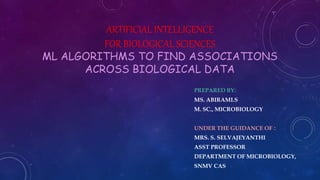
ML algorithms to find associations across biological data.pptx
- 1. ARTIFICIAL INTELLIGENCE FOR BIOLOGICAL SCIENCES ML ALGORITHMS TO FIND ASSOCIATIONS ACROSS BIOLOGICAL DATA PREPARED BY: MS. ABIRAMI.S M. SC., MICROBIOLOGY UNDER THE GUIDANCE OF : MRS. S. SELVAJEYANTHI ASST PROFESSOR DEPARTMENT OF MICROBIOLOGY, SNMV CAS
- 2. CONTENT • Machine Learning • Types of ML • ML algorithm • ML algorithm to find association across biological data • Conclusion
- 3. MACHINE LEARNING • ML stands for "machine learning.“ • It's a subset of artificial intelligence that focuses on the development of algorithms and models that allow computers to learn from data and improve their performance on specific tasks over time. • Instead of being explicitly programmed, these algorithms use data to identify patterns, make predictions, and make decisions. • Machine learning is used in various applications, such as image recognition, language processing, recommendation systems, and more.
- 4. TYPES OF ML • Supervised Learning: Algorithms learn from labeled data, where the input data is paired with the corresponding correct output. Common algorithms include linear regression, decision trees, and support vector machines. • Unsupervised Learning: Algorithms work with unlabeled data to discover patterns and relationships within the data. Examples include clustering algorithms like k-means and dimensionality reduction techniques like principal component analysis (PCA). • Reinforcement Learning: Algorithms learn through trial and error, receiving feedback in the form of rewards or penalties based on their actions. This approach is often used in training agents to perform specific tasks, like playing games or controlling robots.
- 5. ML ALGORITHM • A machine learning (ML) algorithm is a set of rules and mathematical procedures that enables a computer to learn patterns and make predictions or decisions based on data, without being explicitly programmed. • ML algorithms are designed to improve their performance over time as they process more data, allowing them to adapt and generalize from examples. • ML algorithms are a fundamental part of the field of artificial intelligence (AI), and their applications range from image and speech recognition to recommendation systems, autonomous vehicles, and more. • These algorithms can be categorized into different types
- 6. ML ALGORITHMS TO FIND ASSOCIATION ACROSS BIOLOGICAL DATA Machine learning algorithms play a crucial role in analyzing and identifying associations across biological data. Here are some commonly used ML algorithms for this purpose: • Apriori Algorithm: Widely used in association rule mining, the Apriori algorithm identifies frequent itemsets in datasets. In biology, it can discover co-occurrence patterns among genes, proteins, or metabolites, revealing potential interactions or functional relationships. In genomics, for example, Apriori can reveal associations between mutations in different genes that occur together more frequently than by chance. This information can provide insights into potential genetic interactions and pathways.
- 7. • Random Forest: The Random Forest algorithm excels at classification tasks and feature importance analysis. In the realm of biology, it aids in predicting gene functions, identifying associations between genes and phenotypes, and even distinguishing between healthy and disease states based on intricate biological features. Image courtesy: https://images.app.goo.gl/vVGU8VrYV2wdYWq47
- 8. • Support Vector Machines (SVM): SVM is employed to classify and predict biological interactions, such as protein-protein interactions or drug-target associations. By learning patterns from known data, SVM can predict potential associations within biological datasets. Image courtesy: https://www.javatpoint.com/machine- learning-support-vector-machine-algorithm
- 9. • Deep Learning and Neural Networks: Deep learning techniques, including Convolutional Neural Networks (CNNs) and Recurrent Neural Networks (RNNs), have revolutionized biological data analysis. CNNs excel at image analysis, helping identify associations by analyzing cellular structures, while RNNs predict sequences, unveiling relationships in genetic or protein data. Image courtesy:https://images.app.goo.gl/1g2MjMhLG2E1Ttr56
- 10. • Bayesian Networks: With their ability to model probabilistic relationships, Bayesian networks are invaluable for exploring associations and dependencies within biological data. These networks can reveal causal relationships between genes, proteins, and diseases, offering insights into regulatory networks. Image courtesy: https://images.app.goo.gl/GMMBBjqi1bQ65yC KA
- 11. • Graph-based Methods: Biological entities and their relationships can be represented as graphs, with nodes representing entities and edges representing associations. Graph algorithms, such as clustering and centrality analysis, help identify modules and key entities, uncovering associations within intricate biological networks. Image courtesy: https://encrypted- tbn0.gstatic.com/images?q=tbn:ANd9GcT2GNEMFbiau Yn_ccmOcy4TzMkCLdAHBVhozw&usqp=CAU
- 12. • Dimensionality Reduction Techniques: Algorithms like Principal Component Analysis (PCA) and t- Distributed Stochastic Neighbor Embedding (t-SNE) reduce the dimensionality of high-dimensional biological data. These techniques can help visualize and identify associations between samples or variables. Image courtesy: https://www.geeksforgeeks.org/dimensionality-reduction/
- 13. • Association Rule Mining Algorithms: Apart from Apriori, other association rule mining algorithms like FP-Growth and Eclat are used to uncover hidden relationships between biological entities. These algorithms are particularly useful in analyzing large- scale genomic data. Image courtesy: https://images.app.goo.gl/EBMjBt9Uf7Q6zQKh9
- 14. • Enrichment Analysis: While not a single algorithm, enrichment analysis techniques like Gene Ontology (GO) analysis or pathway enrichment can reveal associations between biological entities based on their functional annotations. These methods help interpret the biological significance of associations.
- 15. • Transfer Learning: Transfer learning involves leveraging knowledge from one biological context to make predictions in another. It's valuable for finding associations across related biological datasets and adapting models trained on one dataset to another. Image courtesy: https://images.app.goo.gl/m8DoqrDx7hociC8b7
- 16. CONCLUSION • Machine learning algorithms offer diverse and powerful tools for uncovering associations within biological data. • By utilizing these algorithms, researchers can extract meaningful insights that contribute to our understanding of biological processes, disease mechanisms, and potential therapeutic targets. • These algorithms, ranging from traditional techniques to deep learning models, empower researchers to uncover associations that might otherwise remain hidden in the intricate web of biological information. • As technology advances, the synergy between machine learning and biological research promises to reshape our comprehension of life's complexities, leading to breakthroughs in medicine, agriculture, and beyond.
- 17. REFERENCE Articles: • https://www.sciencedirect.com • https://www.researchgate.net • https://academic.oup.com Other resources: • https://chat.openai.com
- 18. THANK YOU